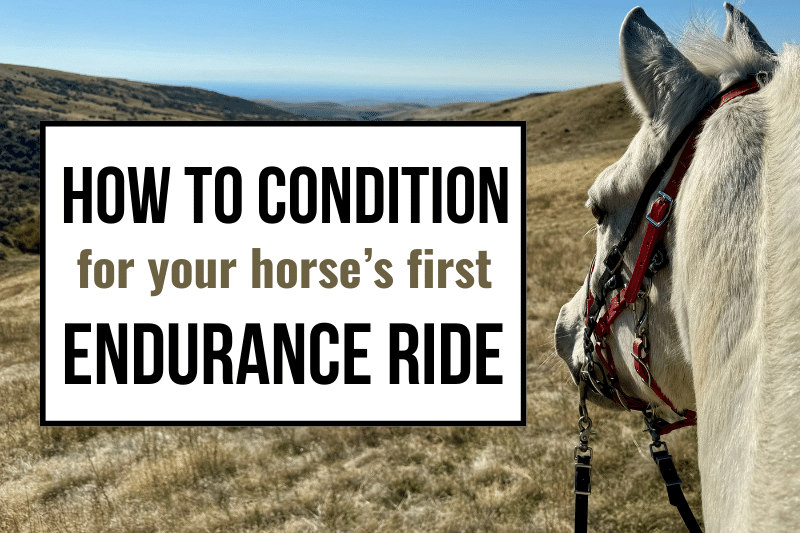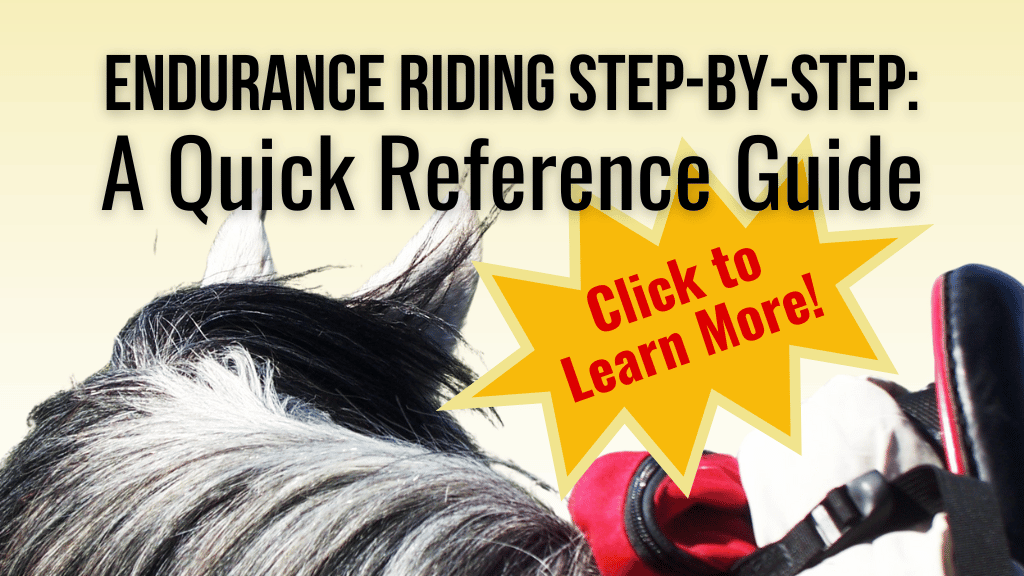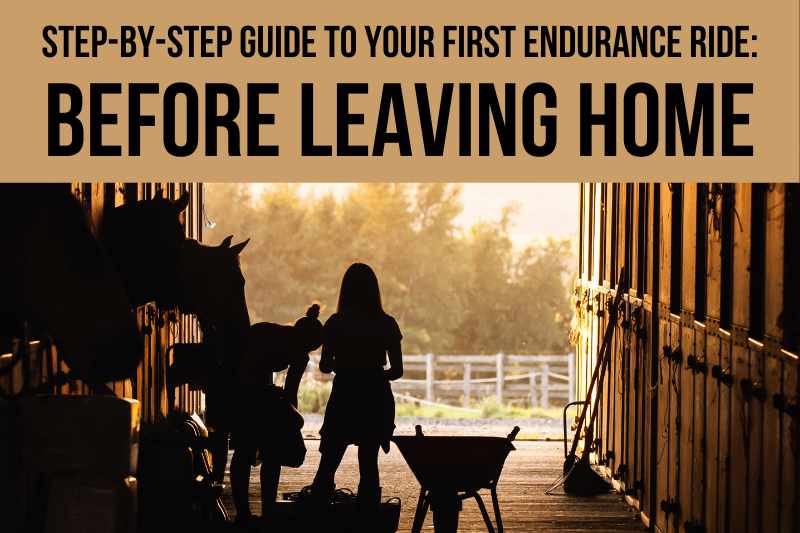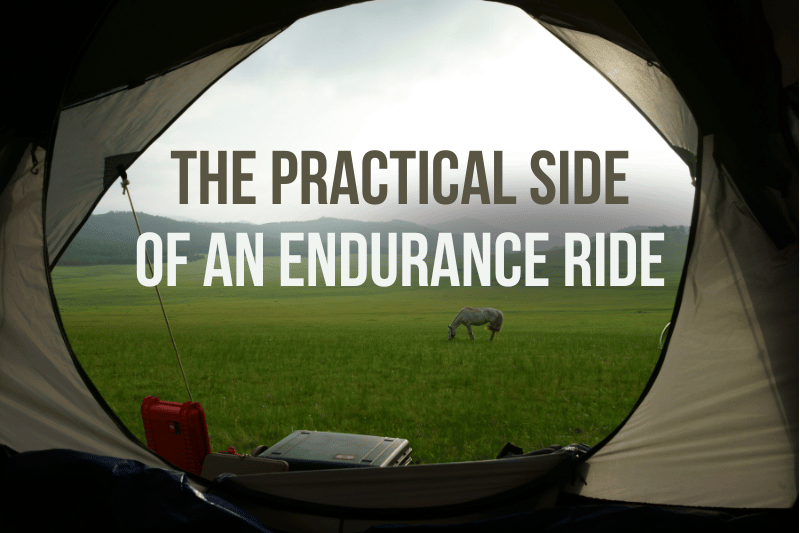Fifty miles in one day. It sounds like an impossible feat. Even 25 miles feels unattainable. But you know riders do it, and you want to give it a go. Welcome to the challenge of equestrian endurance riding! Right out the gate, you’re going to want to know how to condition your horse.
Preparing a horse for his first endurance ride involves both training his mind and conditioning his body. This post introduces a simple approach to building your horse’s physical fitness.
Like many riders, I am prone to overplanning. I once calendared every single conditioning ride a year in advance. (You can imagine how that worked out!) Thankfully, I eventually learned that while conditioning a horse for his first endurance ride isn’t necessarily easy, it may be simpler than you think.
Here’s how to do it:
Get Clear on Your Goal
A critical first step is to really get your head around your goal. For a first endurance ride, your primary objective should be to finish with a healthy, sound horse – not to win.
I promise you won’t be alone. Remember, endurance riding is like marathoning: Almost everyone just wants to complete and have a great time. Very few are trying to place.
Even the most decorated longtime competitor will have much greater respect for a new rider who takes great care of her horse than one who rides too fast.
How Long Does it Take to Condition a Horse for Endurance Riding?
The answer depends on many factors, including:
- How often you are able to ride
- Your horse’s individual response to conditioning
- How fit your horse is before beginning the program
That said, you should anticipate taking at least 4-6 months to prepare a horse for a moderately-paced 50 miler. Plan on 3 months to prepare for a slow, 25-mile limited distance (LD) ride.
It never hurts to err on the conservative side. This is especially true if your horse is young, old, overweight, underweight, recovering from injury, or just pain unfit.
Got an older horse? Check out this post on special considerations for senior endurance horses.
Building fitness takes time. In her book Go the Distance: The Complete Resource for Endurance Horses, endurance rider and veterinarian Nancy Loving points out that while the horse’s cardiovascular system may reach maximum efficiency in three months, muscle tissue takes at least twice that long. Supportive tissues like ligaments, joint capsules, and hooves adapt over about a year, while bones require two years or more to reach their peak.
This doesn’t mean you need to spend two years conditioning before entering an endurance ride, but it does mean you should treat your first two (or more) seasons as though all “races” are just long conditioning rides.
What Does an Endurance Horse Conditioning Program Look Like?
I know from experience that there’s no point trying to plan out every conditioning ride months in advance. Life is bound to get in the way! However, you should have a general idea of how your horse’s conditioning will progress.
This sample program – which should absolutely be modified depending on your individual horse’s needs – relies on the classic, foundational principle of long, slow distance (LSD). The exact definition of “long” and “slow” will shift as your horse gets fitter, but everything you do leading up to your first endurance ride will be LSD…as will the ride itself.
Weeks 1-6
Ride four times per week, including three trail rides and one day of arena work. Your trail rides should be all or mostly at a walk. In the arena, mix up gaits and focus on rhythm, lateral and vertical flexion, independent forequarter and hindquarter control, etc.
Depending on your horse’s baseline fitness, your trail rides may begin with just a few miles and work up to covering about 8 miles in around 2.5 or 3 hours. This is a perfect time to teach your horse to walk out like he’s on a mission.
Be sure your horse gets plenty of rest. Fitness is built in response to appropriate levels of stress that slowly increase over time (known as progressive loading). It relies upon recovery and good nutrition – not excessive work.
Rest days are a great opportunity to work on training your horse the skills he’ll need for his first endurance ride. You can also take him for hand walks to build your own fitness.
Weeks 7-12
Continue riding four times per week, including three trail rides and one day of arena work. Add in some trotting – just 10% of your trail ride at first and building up to 50% or so. Try not to increase both speed and distance in the same ride; if you go faster, keep the mileage shorter, and vice versa.
This is a good time to start doing one “long ride” per week. This ride could get as long as 15 miles, while your other two trail rides are half that distance. Incorporating hill climbs into your conditioning rides will afford your horse tremendous muscular and cardiovascular benefit without excessive stress on his structures.
As your pace and distance creep up, monitor your horse’s attitude. He should be bright and eager, not evasive or grumpy. Check his back and legs daily for any hint of heat, swelling, or pain.
If you feel like your horse is tired or uncomfortable, back off the workload immediately. You will always reach your goal faster by listening to a whisper rather than waiting for a scream.
If your horse is feeling great around the 3-month mark, he is probably ready for his first LD. Shoot for an average pace of 6 miles per hour. That’ll probably align you with the age-old advice to “trot when you can, walk when you have to.” It will also give you a little cushion for finishing without going overtime – but if you do go over the limit, do it on time and not on your horse’s ability.
Weeks 13 and Up
Keep a similar schedule and continue to gradually increase the percentage of your trail rides that is spent at a trot. Some of your shorter rides (8 miles or so) might now be all trotting except your warmup and cooldown. Meanwhile, your long rides can stay at about 15 miles, but you’ll do more trotting.
If you’re preparing for an LD, your longest conditioning ride never needs to exceed 15 miles. If you’re preparing for a 50, your longest conditioning ride might be 25 miles, but you only need to do that once. I like to schedule it for about 3 weeks prior to my goal 50 – definitely not less than 2 weeks prior.
If you haven’t already, this is a good time to find out more about the trail at your goal event. If the ride features lots of climbing and descending, work more hills into your conditioning program. If the ride has sandy footing, look for some sand to condition in (slowly! Deep sand puts a lot of stress on tendons and ligaments.)
As your horse’s body changes, keep a close eye on tack fit. The saddle that worked for him at the beginning of your program might not be feeling as good now. Make sure you’ve also figured out the right bit or bitless bridle, hoof protection, saddle pad, and everything else to keep your horse comfortable.
2 Weeks Before the Ride
You want your horse to start his first endurance ride well recovered. Do his last long ride two weeks before the event. Then, spend the last week doing only short, “shakeout” trots of 6 miles or so. You definitely don’t want to leave your fit horse just standing around; doing so risks rhabdomyolysis (tying up) when you do hit the trail.
When you finally get to the starting line, remember to keep your goal front and center no matter with: Finish with a healthy, sound horse. When in doubt, slow down. A slower ride means more time with your equine partner – both today and for years to come.
Maintaining Your Endurance Horse's Fitness
Once your horse is fit for your desired distance, you don’t need to work as hard to keep him there. Horses retain their fitness much longer than humans do (think months instead of weeks), and they benefit from substantially more rest.
Most endurance riders give their horses at least a week off after an LD or 50. I continue to follow the advice of my mentor and the author of America’s Long Distance Challenge, Karen Bumgarner, and give my horse a week of rest for every 25 miles of competition.
As long as you rode him appropriately, your horse will experience a massive fitness boost from his first endurance ride. After a week or two of turnout, you’ll have a dragon on your hands!
…which will serve as a great reminder: You need to do more than just condition your endurance horse. You need to train him as well. Check out these 8 Skills to Practice Before Ride Day.
Did You Ever Wish You Could Have a Mentor in Your Pocket?
You need my Endurance Riding Step-by-Step Quick Reference Guide! Just download it to your phone and use the clickable Table of Contents for speedy access to all the details nobody thought to tell you, so you can embark on your endurance adventure with confidence. Click to learn more!
Further Reading
Any good endurance horse conditioning plan will rely heavily on LSD. However, there are plenty of variations on the theme. Here are some excellent articles to check out:
Preparing Your Horse for the (Crazy-Fun) Sport of Endurance Riding by Jeanette Mero, DVM
Conditioning for Your First Endurance Ride from Southeast Endurance Riders Association
Conditioning from Green Bean Endurance
You might also like
This post includes affiliate links, and I may earn a small commission (at no extra cost to you) when you purchase through these links. I only recommend products and services I think are helpful and useful. Thanks for helping me offset the cost of maintaining this blog as a free resource!




